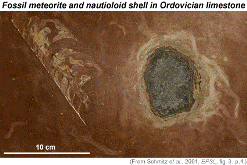
By some kind of coincidence, Thorslund had been the first to describe the impact breccia of the Lockne crater (though without realising its impact origin). As ideas about terrestrial impacts became more widespread during the 1970s, and people began to look at the Siljan Ring in this context, Thorslund was struck by the notion that perhaps that mysterious clast was in fact a fossil meteorite. The slab was dusted off and re-examined – and although its mineralogy was entirely pseudomorphed by common minerals like calcite and barite, clearly chondritic structures were identified. Thorslund had found the first ever confirmed fossil meteorite – now known as Brunflo, from the nearest town to the Rödbrottet Quarry, Gärde, where it had been unearthed all those years before. Thorslund’s paper appeared in
Nature, eleven months before his death, in 1979. “He did so much to build the foundations” says Schmitz. “If only he had lived a little longer, to see where it would all lead!”
Soon after his return to Sweden from the US, Schmitz got to hear of the discovery of another Ordovician fossil meteorite, from slightly older rocks, several hundred kilometres to the south of Brunflo. Once again, the host rock was a limestone, a condensed deposit laid down at the rate of only two millimetres every thousand years. The pinkish Orthoceratite Limestone, quarried for building and paving since the 12th Century, came from Thorsberg Quarry. Local geologist Mario Tassinari came to hear about it from his local newspaper in Linköping, and was quickly on the scene asking the quarrymen if they knew of any more. It wasn’t long before more appeared.
Before long, Schmitz had begun a systematic sampling project to find more meteorites. Since this project started, in 1993, 90 individual meteorites have been recovered. “It is remarkably predictable” Schmitz told the Meteoritical Society yesterday. “Each year in Thorsberg Quarry, another 750 square metres of Ordovician sea floor is quarried, and each year it produces six, plus or minus two meteorites. Up till now, 12,000 square metres of seafloor have been excavated. Of the 90 meteorites found, 65 have been analysed and all have been diagnosed as L chondrites.”